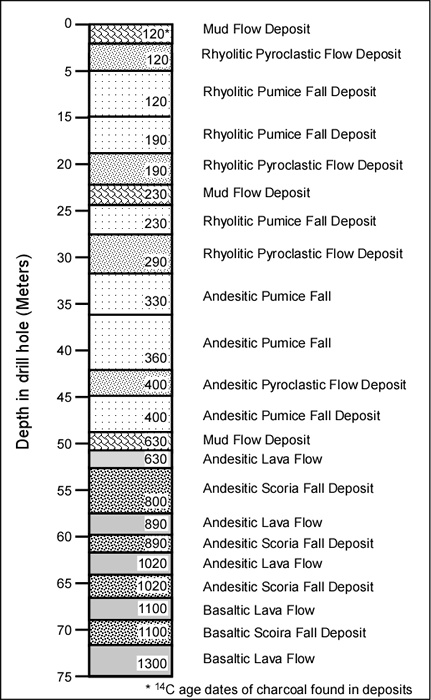- Having decided to keep your job as Regional manager for Denyallclaims
Insurance Company in the San Francisco Bay area (and keep your home in
Mill Valley), the executives at the main office assign you a new task.
A company is requesting insurance coverage on a ski resort they are
planning to build in a South American country bordering on the Pacific
Ocean. The ski resort will be built at the base of a conical
mountain peak where a valley cut into the side of the mountain empties
onto a broad flat plain. You are asked to evaluate the risk of
building in this locality. Since you suspect that the mountain
is a stratovolcano, you decide to go check it out for yourself.
Upon arrival at the site, you find that there are few rocks or deposits exposed on the valley floor that might give you a hint as to what has been happening at this mountain in the recent past. There are rumors among the people living nearby that the mountain has erupted a couple of times in the past few hundred years, but, they claim that this is nothing to worry about, as it has been a long time since the volcano erupted and the locals consider it to be an extinct volcano. Because you have taken a course on natural disasters, you realize that relying on local rumors may cost you your job, your Mill Valley house, and maybe even your spouse, you decide to acquire more information.
You find a local geological consulting firm that is capable of drilling a hole 75 meters deep into the valley floor. The company will take core samples of the entire drill hole, and, if they encounter any charcoal within the samples, provide you with 14C age dates of any charcoal they find. When finished, they provide you with a chart, shown on the next page, that shows the depth within the drill hole, a description of the deposits found in the drill hole, and the 14C age of the charcoal they found in the layers (shown as numbers within the layers). Because a 14C age date on charcoal is the date when the original tree or twig died due to exposure to hot volcanic material, it gives a fairly precise date on the eruption which caused the formation of the charcoal. The drill hole data gives a fairly complete picture of the events that have occurred at this particular locality. Other eruptions may have occurred, but they did not leave deposits in this valley.
From this information, you want to answer the following questions for your report to corporate headquarters.

- Describe in general how the history of the volcano, as determined in this particular valley, has changed through time as revealed by the deposits found with depth in the drill hole. In particular note how the SiO2 content of the magmas has changed with time and whether or not this is reflected in the explosivity of the eruptions as revealed by the deposits. (2 points)
- Note that the drill hole data shows two distinct periods of eruptive style of the volcano as exhibited by the deposits. How would you characterize these different periods and when did the change occur? (2 points)
- The average eruption rate, R, (number of eruptions/year) can be obtained by dividing the number of eruptions by the time over which the eruptions occurred*. The average eruption frequency (number of years between eruptions) is then 1/R. What is the average eruption rate and average eruption frequency for (i) the entire sequence represented by the layers represented in the drill hole and (ii) the two different eruptive periods? (Note that in counting eruptions, it is likely that two deposits of different type that have the same 14C age date, probably represent a single eruption) (3 points).
*Note that in considering the time periods for this exercise, you should use the range from the first eruption of the period to the beginning of the next period. For example the time range for the entire sequence should be 1300 minus 0, the time range for the first eruptive period should be1300 minus the date of the beginning of the next period, and time range for the second eruptive period should be the date of the beginning of the second eruptive period minus 0).
- What are the three most likely volcanic hazards expected in this valley? (1 point).
- Based on the above information, provide a one paragraph statement to Denyallclaims corporate headquarters that explains the hazard(s) and evaulates the risk of building a ski resort at this locality? (3 points)